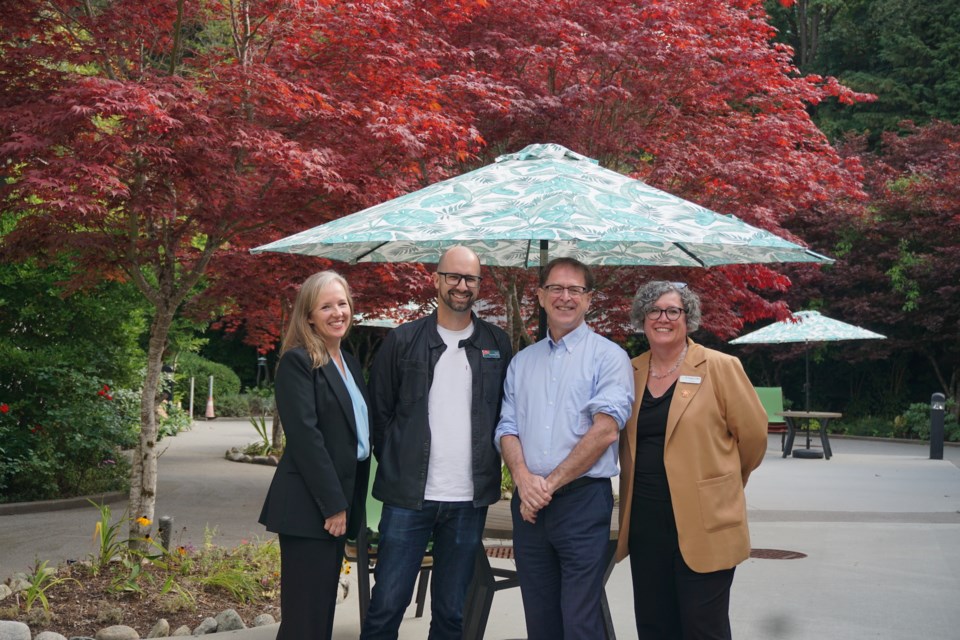Squamish is set to get a new long-term care home that will provide 152 beds, nearly doubling the capacity of the current Hilltop House.
The $285-million project, scheduled to begin construction in 2027, is expected to open its doors by 2030.
“This is the only care home north of West Vancouver, and it serves a really vast geographic region,” said Health Minister Adrian Dix at a press conference in front of Hilltop on Monday morning.
The new facility will be on Loggers Lane, just seven minutes from the current Hilltop House.
The existing facility, built decades ago, currently has 90 beds.
"We’re replacing Hilltop House, which has 90 beds in total ... we're going to replace it with a new facility that’s going to have 152 long-term care beds," Dix said.
Many older residents of Squamish have been forced to move to care homes elsewhere due to the local shortage of beds.
“Our fastest-growing demographic is actually seniors,” said Squamish Mayor Armand Hurford.
“Older people have had to move to care homes on the North Shore or even in Vancouver due to the shortage of beds in Squamish.”
The new care home aims to address these gaps and bring relief to Squamish’s aging population.
Dix highlighted the significance of the project, pointing to the historical underinvestment in long-term care across British Columbia.
"In the 10 years before I became Minister of Health, the government spent $17 million on long-term care in British Columbia—that’s about three beds a year," said Dix. "In contrast, our long-term care budget now is $3.2 billion."
Why the delays?
The long-awaited care home in Squamish has faced delays due to under funding and the impact of the COVID-19 pandemic.
Dix said that when he took office, 90% of existing long-term care beds in the province were below staffing standards.
“There was a lack of care for the people in long-term care,” Dix said, adding that many care homes in B.C., built in the 1960s, needed urgent replacement. “We have to replace beds that aren’t going to last, and then we’ve got to add new beds because we’ve got a lot more seniors.”
According to Dix, the pandemic also played a role in delaying the project.
“During the pandemic, we worked on a report called In Plain Sight, which talked about anti-Indigenous racism in the healthcare system. It was critical to address those issues properly, which took time,” he said.
Indigenous involvement and cultural safety
Dix emphasized the importance of Indigenous input during the planning process, noting that the In Plain Sight report helped guide the project.
“Vancouver Coastal Health has been a leader in this regard, with both members of our board, representing Indigenous communities, including the Sḵwx̱wú7mesh Úxwumixw (Squamish Nation), involved in the project,” said Dix.
This involvement will be reflected in various aspects of the facility, from the meals served to the art and design throughout the building, said Dix. "Cultural safety is central to what we do," he added at the press conference.
"The new building is going to reflect that in its construction and in its day-to-day functioning."
Dix added that similar efforts have been made in other regions, such as Tk’emlúps (Kamloops), where Indigenous participation has been key to the success of long-term care facilities.
“Indigenous people are here now and will continue to be, and it’s important that the care home reflects that,” Dix said. He also stressed the need to recruit Indigenous people from the region to work in the facility, adding, “We need to create more opportunities for them to work in these facilities, to be part of the community.”
Future of the Hilltop House Site: What Comes Next?
"These are replacement beds for long-term care ... but there’s a conversation to be had with the community about what happens to Hilltop House," said Minister Dix.
"This facility could serve other purposes, and we’ll engage with the community on that... There are lots of options in terms of care, housing, or other uses," he added.
"We considered expanding Hilltop House, but building a major facility on a single site was the best option to meet long-term care needs," Dix said. "Splitting between two locations wouldn’t make sense."
The existing Hilltop House site could still be “repurposed for other levels of care or housing,” according to Dix, emphasizing a community-driven dialogue.
Bhagyashree Chatterjee is The Squamish Chief’s Indigenous affairs reporter. This reporting beat is made possible by the Local Journalism Initiative.




